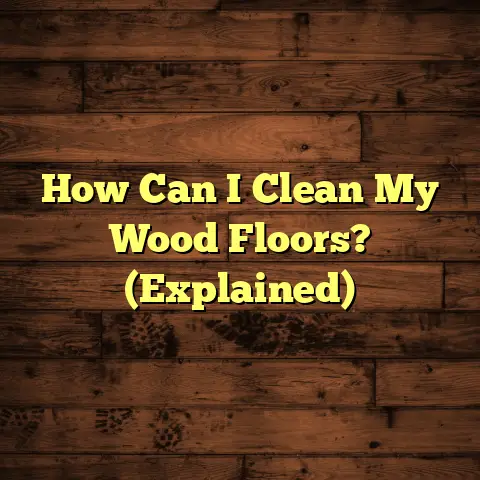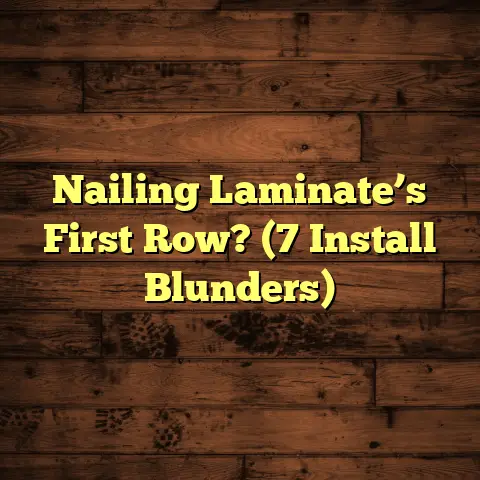Asbestos Tile: What Does It Look Like? (Check NOW!)
Hey folks!
Did you know that the EPA estimates around 3,000 people in the U.S. die each year from asbestos-related diseases?
That’s a scary number, and it highlights why knowing about asbestos, especially in older homes, is super important.
Let’s dive in and learn how to spot these potentially hazardous tiles.
Section 1: Understanding Asbestos
So, what exactly is asbestos?
It’s a naturally occurring mineral, and what makes it unique is its incredible resistance to heat, fire, and chemicals.
Think of it as nature’s super-insulator.
Because of these properties, asbestos was a superstar in the construction world for decades, especially before the 1980s.
It was used in everything from insulation to roofing, and, you guessed it, flooring.
Now, when we talk about asbestos in tiles, we’re usually dealing with a few main types:
- Chrysotile (white asbestos): This is the most common type.
- Amosite (brown asbestos): Less common than chrysotile.
- Crocidolite (blue asbestos): The least common but considered the most dangerous.
Section 2: Types of Asbestos Tiles
Alright, let’s get specific about the types of asbestos tiles you might encounter.
The most common culprit is Vinyl Asbestos Tile (VAT).
These were super popular back in the day because they were durable, cheap, and came in a ton of colors and patterns.
Then you have Asbestos Cement Tiles.
These are less common for flooring, but you might find them in older buildings.
And lastly, Asbestos-Backed Tiles.
These are tiles that have a layer of asbestos material on the back for insulation or added strength.
Identifying these different types can be tricky, but here’s what I’ve learned over the years:
- VAT: Usually 9″x9″ or 12″x12″ squares, but other sizes exist. They can be brittle and crack easily.
- Asbestos Cement Tiles: Often larger than VAT, and have a more “concrete-like” appearance.
- Asbestos-Backed Tiles: Harder to spot without removing a tile (which you shouldn’t do yourself!).
Section 3: Visual Identification of Asbestos Tiles
Okay, time for the visual inspection!
What do these asbestos tiles actually look like?
Well, VAT, for example, came in a rainbow of colors, but you’ll often see:
- Black
- Gray
- Brown
- Green
Patterns varied too, from:
- Speckled
- Marbled
- Solid colors
As for the surface texture, it’s usually pretty smooth, but older tiles might have a slightly rougher feel due to wear and tear.
The age of the tile is a big clue.
If your home was built before the 1980s, the chances of asbestos tiles being present go up significantly.
Think of it this way: the older the tile, the higher the likelihood.
Section 4: Signs of Asbestos Tile Presence
So how do you play detective and figure out if you might have asbestos tiles?
First, consider the year your home or building was constructed.
As I mentioned, pre-1980s is a red flag.
Next, think about where these tiles are commonly found.
Basements, kitchens, and bathrooms are prime suspects.
These were areas where durable, water-resistant flooring was highly desirable.
Now, what should you look for in terms of wear and damage?
Cracking, curling, or fraying are all signs that the tile is deteriorating.
If you see these issues, it’s even more important to get things checked out.
Section 5: Health Risks Associated with Asbestos Tiles
Let’s talk about the elephant in the room: the health risks.
The real danger with asbestos isn’t the tile itself, but the fibers that can be released into the air when the tile is disturbed, damaged, or removed.
When you breathe in these tiny fibers, they can get lodged in your lungs and cause some serious problems down the road, including:
- Asbestosis: A chronic lung disease that causes scarring and difficulty breathing.
- Mesothelioma: A rare and aggressive cancer that affects the lining of the lungs, abdomen, or heart.
- Lung cancer: Asbestos exposure significantly increases your risk of developing lung cancer.
I can’t stress enough how important it is to recognize and address asbestos tiles in the context of your health and safety.
It’s not something to take lightly.
According to the National Cancer Institute, most people don’t develop asbestos-related diseases until 10-40 years after the initial exposure.
Section 6: Regulatory Standards and Guidelines
Okay, let’s talk about the rules of the game.
In the U.S., the EPA (Environmental Protection Agency) and OSHA (Occupational Safety and Health Administration) have strict regulations surrounding the use and removal of asbestos.
These regulations are in place to protect both homeowners and workers from exposure.
For example, OSHA has specific requirements for asbestos abatement workers, including training, protective equipment, and air monitoring.
The EPA also has regulations regarding the disposal of asbestos-containing materials.
Compliance with these regulations isn’t just about avoiding fines; it’s about protecting your health and the health of others.
Section 7: Next Steps for Homeowners
So, you suspect you have asbestos tiles. What do you do now?
Here’s a clear action plan:
- Seek professional inspection and testing: Don’t try to remove a tile yourself! Hire a qualified asbestos inspector to take samples and test them in a lab.
- Discuss options with licensed asbestos abatement contractors: If asbestos is confirmed, talk to contractors about removal or encapsulation. Encapsulation involves sealing the tiles to prevent fiber release.
- DO NOT ATTEMPT DIY REMOVAL: I can’t emphasize this enough. DIY asbestos removal is extremely dangerous and illegal in many areas.
Remember, safety first!
Conclusion
Alright, we’ve covered a lot of ground here.
We’ve talked about what asbestos is, what asbestos tiles look like, the health risks involved, and what to do if you suspect you have them in your home.
The key takeaway is that recognizing asbestos tiles and understanding the potential health implications is crucial.
Stay informed, take the necessary precautions, and don’t hesitate to seek professional help if you have any concerns.
Your health is worth it!





